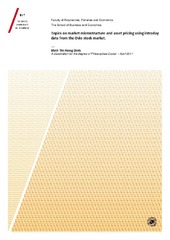Topics on market microstructure and asset pricing using intraday data from the Oslo stock market.
Permanent link
https://hdl.handle.net/10037/11295View/
Thesis (PDF)
Paper 1: Dinh, M.T.H.: “The returns, risk and liquidity relationship in high frequency trading: Evidence from the Oslo stock market”. Also available in Research in International Business and Finance 2017, 39, pp.30-40. (PDF)
Paper 2: Dinh, M.T.H.: “The relationship between volume imbalance and spread”. (Manuscript).Published version available in Research in International Business and Finance 2017. (PDF)
Date
2017-08-23Type
Doctoral thesisDoktorgradsavhandling
Author
Dinh, Minh Thi HongAbstract
What drives asset prices in the financial market? How can we predict these prices? Finding
the relationship between different factors or between different variables could help to answer
these questions. First, links between asset pricing models and other market microstructure
variables can be used to investigate sources to explain asset prices. Second, rapid changes in the
microstructure of the financial market in which investors can trade with high frequency have
provided a platform for researchers to examine the relationship between microstructure variables in
high frequency trading. Therefore, this thesis first links two theories, asset pricing and market
microstructure, and then focuses on the market microstructure area.
In the first paper, the relationship between returns, risk and liquidity in high frequency trading
is investigated. The results of this research mainly suggest that in high frequency trading
idiosyncratic risk plays a more important role than systematic risk in asset pricing. In addition,
liquidity has a higher effect on idiosyncratic risk than systematic risk. In the second paper, the
relationship between the spread and the quoted volume imbalance is investigated. The results
suggest that for the liquidity sample the relationship is negative if the imbalance is higher than
1, and positive if the imbalance is lower than -1. This means that if the imbalance is high enough,
it affects the spread. For low liquidity samples, there is no obvious relationship between them. In
the third paper, we investigate whether asymmetric information appearing in the financial market
affects the order imbalance reversal effect; the main results
suggest that it does.
Description
The paper 3 of this thesis is not available in Munin.
Paper 3: Sirne, E., Dinh, M.T.H.: “The OIB-reversal effect and asymmetric information” (Manuscript).
Paper 3: Sirne, E., Dinh, M.T.H.: “The OIB-reversal effect and asymmetric information” (Manuscript).
Publisher
UiT The Arctic University of NorwayUiT Norges arktiske universitet
Metadata
Show full item recordCollections
Copyright 2017 The Author(s)
The following license file are associated with this item:


 English
English norsk
norsk
